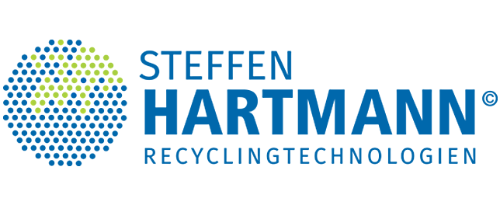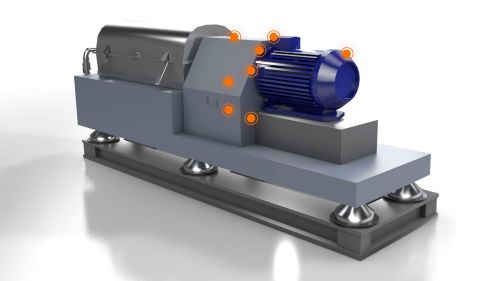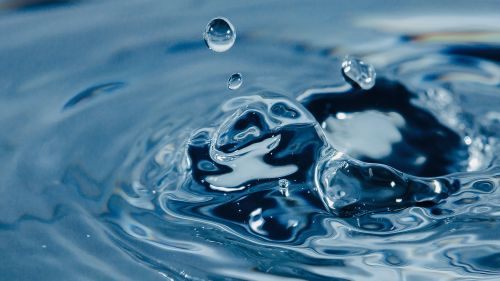Steffen Hartmann Recyclingtechnologien – Vacuum evaporator
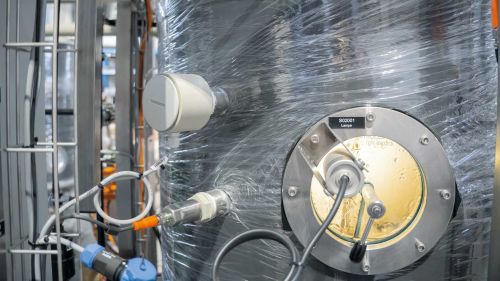
In the boiling chamber, the polluted medium evaporates at around 40°C under vacuum, and is thus separated into clean distillate and concentrate. LMT sensors monitor the level in the chamber at different heights.
Efficient industrial water treatment using IO-Link
Vacuum evaporation is a suitable method for treating industrial wastewater such as coolants. Vacuum evaporators separate water from contaminants and treat it for reuse. Intelligent sensors ensure low-maintenance, cost-effective operation.
In many industrial processes, liquids are treated to be reused, ensuring a low carbon footprint and reducing disposal costs. A common example is the treatment of coolant emulsions used in machine tools. In addition to mechanical cleaning, the waste oil must also be separated from the water.
The company Steffen Hartmann Recyclingtechnologien GmbH from Thale in the German Harz region specialises in the development and manufacture of wastewater treatment plants, including vacuum evaporators.
Managing Director Sascha Holthusen explains: “Our vacuum evaporator has been specifically developed for treating this kind of industrial wastewater. The consumed coolant emulsion is fed in, and out comes a small amount of concentrate as well as a clean distillate, the pure water, which can be used for other processes or discharged to the sewer system, eliminating cost-intensive disposal.”
In vacuum conditions
The operating principle of the vacuum evaporator consists of “boiling” the polluted medium in a boiling chamber. Similar to a kitchen stove, heat is supplied to the lower part of the container, resulting in clean water vapour, which is condensed in the boiling chamber and discharged. The contaminated concentrate remains at the bottom.
But why is the process conducted under vacuum? Sascha Holthusen explains: “In vacuum conditions, water boils at lower temperatures, in this case already at 40°C. At this temperature, we can even evaporate more aggressive media such as acids or alkalis without damaging the stainless steel walls, as would happen at higher temperatures. Also, certain substances remain in the concentrate at this relatively low temperature and do not separate. Another advantage of vacuum evaporation is that we need less energy for heating. For this purpose, we use an efficient refrigerant compressor. The way it works is similar to a heat pump, and it is more energy-efficient than direct electric heating, for example. The same refrigerant allows the water vapour to be condensed. Alternatively, we can also use the existing process heat of our customers, which we then feed to our vacuum evaporator via a heat exchanger.”
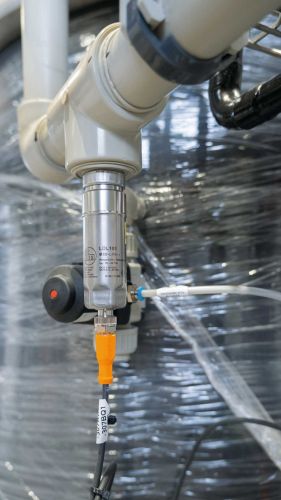
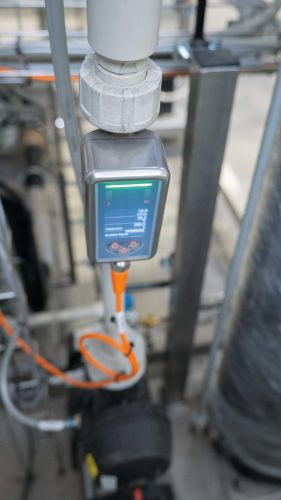
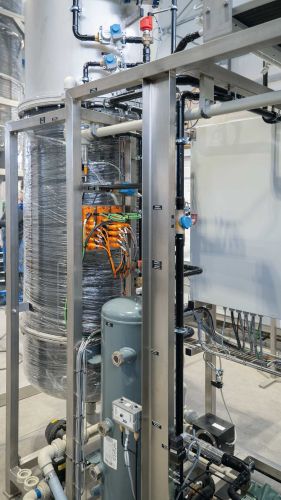
Image 1: The LDL101 conductivity sensor monitors the purity of the distillate.
Image 2: Specially designed for aggressive ultra-pure water, the SU flow sensor measures the amount of distillate.
Image 3: All sensors are connected via IO-Link. This reduces set-up times, facilitates parameter setting and enables remote diagnosis right down to the sensor level.
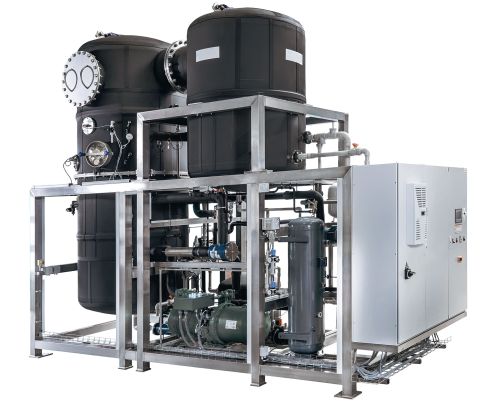
Vacuum evaporator from Steffen Hartmann Recyclingtechnologien
Process parameters at a glance
As part of process monitoring, key parameters such as pressure and temperature are monitored. ifm sensors continuously monitor these parameters to optimally manage the evaporation process. They control both the heat supply and the vacuum pump.
Another decisive factor is the level in the boiling chamber, which is precisely monitored by LMT level sensors installed in the tank wall at different heights. The medium supply is stopped as soon as the upper level sensor reacts, and resumed when the level drops to the lower sensor.
Further LMT sensors are installed in the coolant supply tank of the vacuum pump for level monitoring at three different positions. Yet another LMT sensor is installed in the distillate collection tank. As soon as its maximum capacity is reached, the sensor provides a switching signal, which causes the distillate to be pumped out.
LMT level sensors are distinguished by their hygienic design. Their high-quality housing materials such as PEEK and stainless steel (316L / 1.4404) are highly resistant to aggressive media. Foam and other potential deposits are automatically suppressed and cannot affect the sensor performance, ensuring continuous and reliable level detection.
Water quality measurement
Continuous water quality monitoring is essential, especially when it comes to ensuring the purity of the distillate. For this task, an LDL101 conductivity sensor is used. Its measured value secures the quality of the entire evaporation process and of the pure water obtained from it.
The ultrasonic flow meter “SU Puresonic” has been optimised specifically for applications in pure and ultra-pure water. This sensor can precisely determine the amount of distillate. Its component-free measuring pipe is made of high-grade stainless steel, providing excellent resistance to aggressive media. It is important to note that “pure” or distilled water, while it may sound harmless, can be aggressive toward metal materials. and requires special stainless steel alloys. Interestingly, this sensor is often used in plastic pipes, as they are not affected by pure water.
Pump monitoring prevents damage
A central unit of the system is the vacuum pump. If it is not adequately cooled or if the vacuum becomes too strong, unwanted cavitation can occur on the impellers, which can lead to material wear. Cavitation produces extraordinary vibrations. A vibration sensor installed in the housing of the vacuum pump detects any unusual vibration patterns and transmits them to the controller. As a result, an unloading valve will open automatically and secondary air will be supplied to bring the pump operation back to its normal state. This effectively prevents expensive pump damage.
Digitisation with IO-Link
All of the sensors used are IO-Link compatible, offering a real added value that goes far beyond the simple transmission of measured values or switching signals: IO-Link enables users to access the sensors remotely, read data and diagnostic values and configure the devices in various ways.
Sascha Holthusen explains the use of IO-Link as follows: “If a customer has a problem with their system, we can connect to it remotely via a VPN connection. In the past, without IO-Link, we only got as far as the PLC, but not down to the sensor level. With IO-Link, we can now see the status of the system right down to each sensor. We can see whether a sensor delivers measured values or whether a specific error occurred in the IO card of the PLC or in the cabling. We can also read the sensor’s diagnostic values and adjust its parameters remotely if necessary. If the customer has replaced a sensor, we can configure it remotely. Thus, IO-Link offers us and our customers a considerable advantage in terms of remote maintenance. Another important benefit is the scalability of the measured sensor values, which we can configure via IO-Link. We use pressure sensors with a measuring range from -1 to 10bar. We can scale them in such a way that the measuring range covers -1 to 1bar at full resolution. It’s impossible to achieve this with conventional sensors with analogue current output. What’s more, IO-Link sensors can transmit multiple measured values. For example, the flow meter and the pressure sensor also provide temperature values via IO-Link. This reduces the number of required sensors and mounting locations.”
Cost savings through IO-Link
The IO-Link sensors are connected to decentralised IO-Link master modules, which communicate with the PLC via a fieldbus such as PROFINET. This type of cabling has many benefits during installation, as Sascha Holthusen explains:
“Especially with large systems that are dismantled for delivery, this cabling proves to be extremely beneficial. The mechanic who reassembles the system at the customer’s site only needs to connect the plugs. We don’t need an electrician to reconnect wires or route them to the control cabinet. In times where skilled workers are scarce, reducing the time spent on site offers considerable cost saving potential. Another benefit is that the I/O check during system set-up can be done much faster, as no wiring errors or terminal problems occur. While the initial cost of IO-Link may be higher than that of conventional wiring, the time saved during installation and the extended diagnostic and remote maintenance capabilities mentioned earlier ultimately lead to substantial cost savings.”
Conclusion
Cost-efficient water treatment is achieved through two key factors: energy-efficient vacuum evaporation and implementation of a digitalised control concept down to the sensor level. This concept considerably minimises installation and maintenance costs and keeps the boiling point at a low level, which is beneficial both economically as well as ecologically.
